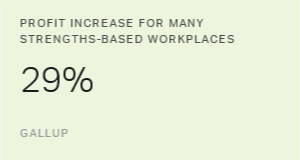Story Highlights
- Gallup studied 49,495 business units in 45 countries
- Strengths-based workgroups saw increases in sales and profits
- Strengths-based companies use seven key strategies
It is easy to speculate about the business benefits of strengths-based development for employees. A Gallup study proves them.
Gallup researchers recently completed an extensive study of companies that have implemented strengths-based management practices. Though many research studies have shown that strengths-based employee development leads to more engaging and productive workplaces, we believe this study is by far the largest and most comprehensive to date.
Gallup studied workgroups using strengths-based interventions to examine the effects those interventions had on workgroup performance. This study included 49,495 business units with 1.2 million employees across 22 organizations in seven industries and 45 countries. Gallup researchers examined six outcomes: sales, profit, customer engagement, turnover, employee engagement and safety. On average, workgroups that received a strengths intervention improved on all of these measures by a significant amount compared with control groups that received less-intensive interventions or none at all. Ninety percent of the workgroups studied had performance increases at or above the following ranges:
- 10% to 19% increased sales
- 14% to 29% increased profit
- 3% to 7% higher customer engagement
- 6% to 16% lower turnover (low-turnover organizations)
- 26% to 72% lower turnover (high-turnover organizations)
- 9% to 15% increase in engaged employees
- 22% to 59% fewer safety incidents
What's more, almost seven in 10 employees (67%) who strongly agree that their manager focuses on their strengths or positive characteristics are engaged. When employees strongly disagree with this statement, the percentage of workers who are engaged in their work plummets to 2%.
These are impressive numbers, especially considering the simplicity of many of the strengths interventions studied. In organizations with a higher percentage of employees participating, more workers learned their strengths and how to use them, likely improving the company's overall results. In all of the companies, the strengths intervention involved employees who completed the CliftonStrengths assessment to identify the areas in which they have the greatest potential for building strengths. But some organizations included in the study did far more, typically accomplishing much more from investing in employees' strengths.
Seven Strategies for Creating a Strengths-Based Culture
In working with hundreds of organizations, Gallup uncovered the characteristics common to companies that accomplished the most with their strengths interventions. These companies achieved results toward the upper end of the ranges mentioned previously in the six outcomes studied. These companies often work toward creating a strengths-based culture using seven strategies:
- Leadership alignment: Putting the elements in place for a strengths-based culture, beginning at the top
- Manager alignment: Developing teams and employees from the perspective of strengths
- Internal communication: Generating awareness of and enthusiasm for strengths
- Strengths community: Making strengths an integral and natural part of the organization's day-to-day operations
- Performance management: Focusing development and recognition on employees' strengths
- Coaching: Building a network of strengths experts and advocates
- Brand building: Tying the organization's strengths-based culture to its larger brand
Organizations that achieve the most with their strengths interventions have an unrelenting commitment to strengths. They weave it into the company's fabric, actively pursuing that culture through the seven powerful strategies. Any organization can use this simple approach to improve its culture and boost business performance.
For organizations seeking to improve performance on crucial business outcomes, strengths-based development is a proven solution. To boost their business, leaders need to start developing people based on what is right with them.
A version of this article originally appeared on the HBR Blog.



